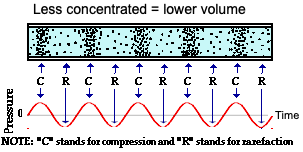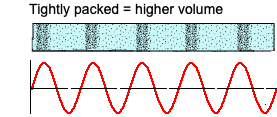 Under Construction. Under Construction.
See also:
Sound Frequency | Sound Loudness | Glossary of Terms |
Audio - stereo - Home Theater (Surround Sound) in home and garden.
Frequency Response Specs
Subwoofers
Is sound important?
Vision and Sound are the 2 most important of the 5 senses (Sight, Sound, Smell, Taste, and Touch).
In the fourth century B.C. Aristotle proposed a hierarchy of senses. His rankings were based on which senses were most important for us to experience and survive in the world. The top sense was sight, followed by hearing. Sight and hearing allow us to sense things from a distance and so were deemed critical for survival. I'd suggest sound was more important because you could sence things in a forest that you couldn't see.
Of course vision is important today for navigation, but intelligent people today spend more time listening to music or news than they do watching TV or movies. [This is circular logic, because I define watching less TV as a characteristic of intelligence as watching less TV.]
What is Sound:
Sound is a mechanical, not electrical wave that results from the back and forth vibration of the particles of the medium (air, water, wook, ...) through which the sound wave is moving.
There are regions in the air where the air particles are compressed together (compressions) and other regions where the air particles are spread apart (rarefactions). The compressions are regions of high air pressure while the rarefactions are regions of low air pressure.

Tuning forks of different sizes were used to generate specific frequencies of sound. Commonly used to tune pianos.
Now frequency can be measured with smartphone apps or special electrical devices.
The distance between the waves are represents frequency. Close = high frequency, spread out = low frequency.

How closely they are packed together represents volume.

The speed of a sound wave depends upon the medium the wave is
moving through. Sound moves faster through dense materials such as
wood or metal because the molecules are close together. Sound also
moves faster through warmer materials because the molecules of a warm
substance are colliding more often than the molecules of a cold
substance.
| Medium | Speed of Sound (m/sec) |
air (0° C./32° F.)
(sea level) | 331 (740 MPH) |
| air (20° C./68° F.) | 344 (770 MPH) |
| cork | 500 |
| alcohol | 1,240 |
| water | 1,500 |
| wood (oak) | 3,850 |
| brick | 3,650 |
| glass | 4,540 |
| aluminum | 5,000 |
| iron | 5,103 |
| steel | 5,200 |
I've seen Mach 1 (the speed of sound) listed as 761.5 and 770 MPH.
Brief History of Recording
From: AUDIO AND HI-FI at www.diarama.cwc.net
The earliest attempts at sound recording is credited to Alexander Graham Bell with his invention of the "Phonograph" in 1877. Sound waves from the subject to be recorded were "captured" by a horn and focused onto a metal diaphragm. The diaphragm was connected to a stylus that traced a groove onto a wax cylinder.
Around 1915 Berliner invented of the Gramophone Disc. Similar in concept to the Cylinder but made from a 10 inch Shellac (an early form of plastic similar to Bakalite) disc rotating at 78 rpm.
1920 Bell System pioneers electrical recording, improved frequency response, lower distortion, the orthophonic phonograph, and the long-playing record.
1933: Stereophonic sound:
Bell Labs transmits first stereo sound, a symphony concert, over phone lines from Philadelphia to Washington.
LP and stereo records
Prior to 1931, most phonograph records were produced by laterally cutting vibrations into wax discs. Bell Labs developed a technique that used vertical cutting, which resulted in better stylus tracking and lower harmonic distortion. It also made possible closer groove spacing for longer playing time. The record "album" was born.
In 1978 digital recording was developed by Philips in Germany. Two years later, Sony of Japan joined Philips to perfect a commercially viable format that was to become known as the "Compact Disc". It was launched in Japan in 1982 and eventually launched in Europe in 1983. The sound signal was represented as "pits" and "troughs" on a protected part of the disc and was "read" by a low powered laser.
Some General Principles
At one time, the range of human hearing was considered to be from 50 Hz to 15 kHz (original definiton of high-fidelity [hi-fi]), and so recordings and playback equipment had to be able to reproduce that range of frequencies. As technical progress continued, the range was redefined as 20 Hz to 20 kHz.
Digital sampling theory requires you sample at twice the maximum frequency you want to record, so CDs record a 16-bit (levels of audio) sample at a rate of 44kHz. See Digital Recording Basics.
While the human ear can't hear pure tones above
about 20kHz, the presence (or absence) of upper
partial tones far above this frequency is clearly
audible because these ultrasonic components
affect the resultant waveform that the ear receives.
Sony and Philips, the co-inventors of the
compact disc, have publicly acknowledged the
inadequacies of the 16-bit/44kHz digital format.
They have a new product called the Super Audio
Compact Disc (SACD) that uses a new digital
recording process called Direct Stream Digital
(DSD). The DSD process extends bandwidth and
dynamic range far beyond the inadequate limits of
compact disc. Sony's literature says the new product is "more like analog."
Sound can be heard from further away in very dry air than in humid air. Water or humidity in the air absorbs much of the sound, thus reducing how far it will travel and still be heard. Wind can also reduce the distance. On a cold, dry winter day you should be able to hear sounds from greater distances than on a day before it will snow.
The density of the air actually only affects the speed of the sound and not the distance it travels.
Glossary of Terms:
dB - Decibells - Bells named for Alexander Graham bell inventor of the telephone and audio engineer.
POS crossover
SI - Système International d'Unités (International System of Units) (SI)
SPL - Sound Pressure Level (dB)
- 5.1
- Dolby Digital sound with five primary speakers (front and rear/left and right plus center) and an LFE (suboofer) channel.
- AA - Audible Audio
- Audible file format (audio books) (Audible.com)
- AAC - Advanced Audio Coding
- An audio compression technology that is part of the MPEG-2 and MPEG-4 standards. AAC, especially MPEG-4 AAC, provides greater compression and superior sound quality than MP3.
ACC is at the core of the MPEG-4, 3GPP, and 3GPP2 specifications and is the new audio codec of choice for Internet, wireless, and digital broadcast arenas.
- AC3
- Adaptive Transform Coder 3 (relates to the bitstream format of Dolby Digital)
- ADPCM - Adaptive Differential Pulse Code Modulation
- takes up less storage space than the regular PCM format used by WAV and AIFF files.
Many MP3 players use ADPCM for their voice-recording feature.
- AIFF/AIFC - Audio Interchange File
- An old uncompressed digital audio file format from Apple. Similar to Microsofts WAV. AIFC is a compressed version.
- ASF (Advanced Streaming Format)
-
- ATRAC3 (Adaptive TRansform Acoustic Coding)
- 20:1 compression
- AU Basic Audio
- 8-bit u-law. Old format from Sun.
- Audible Audio Books
- (AA)
- CDA
- The format of audio on a standard commercial Music CD (RedBook CD).
- FLAC (Free Lossless Audio Codec)
- An Lossless audio compression technology from the Xiph.Org Foundation (www.xiph.org). Files are much larger than MP3.
- LFE
- Low Frequency Effects. Frequencies from 10Hz to 120Hz, normally sent to a subwoofer. The 1 in 5.1
- Lossless
- A method of file compression in which audio data is not permanently discarded. While keeping all of a song's information results in a much bigger sound file, if preserving full audio fidelity is of highest importance, this is the way to go.
- M4A
- Apple iTunes AAC and Lossless format
- Monkey's Audio
- (.ape) - Lossless Compression format
- MP3 MPEG-3
- MPEG Audio Stream, Layer III
- MP4 - MPEG-4
- MPEG-4 is a Video format but has an audiio component
- MPA - MPEG Audio Stream, Layer I, II or III
-
- Ogg Vorbis (OGG)
- open-source audio format created in response to the 1998 announcement by Fraunhofer to begin charging licensing fees for the use of its MP3 format.
- RIAA
- Recording Industry Association of America, an organization representing many music labels, from small indies to the majors. Find out more on its Web site.
- Podcasting
- An audio file, a MP3, most likely, in talk show format, along with a way to subscribe to the show and have it automatically delivered to your computerplayer. It uses RSS (see below). See PodcastingNews.com for software to let you subscribe to and manage podcasts on your PC.
- RA/RAM
- RealAudio
- RAX
- RealAudio 10. RealMedia Streaming file.
- RSS - "Really Simple Syndication" or "Rich Site Summary"
- A lightweight XML format designed for sharing headlines and other Web content. Used by Netscape to fill channels for Netcenter,
- SD2 - Sound Designer II File
- Can be played in QuickTime
- SHN - Shorten files
- It is a lossless compression algorithm for digital music developed by SoftSound.
- VQF- Vector Quantization File
- Transform-domain Weighted Interleave Vector Quantization (TwinVQF) Music File
- WAV - Waveform Audio
- PCM Wave audio. This is a raw audio file often used as the source for encoding other formats or burning CDs. There are several types of wav formats. The most common is PCM (44.1kHz,16 bit, stereo) at 600 MB per hour of audio.
Others include low quality MP3 at 11.5kHz, 16kBit/s mono.
- WMA - Windows Media Audio - lossless
- Microsoft
Links:
Sound | physics.bu.edu
Decibel Scale - an overview | ScienceDirect Topics
Sound Waves as Pressure Waves | physicsclassroom.com
Music
last updated 17 Mar 2022
|
 Technology
Technology
 Sound
Sound
 Technology
Technology
 Sound
Sound
 Under Construction.
Under Construction.